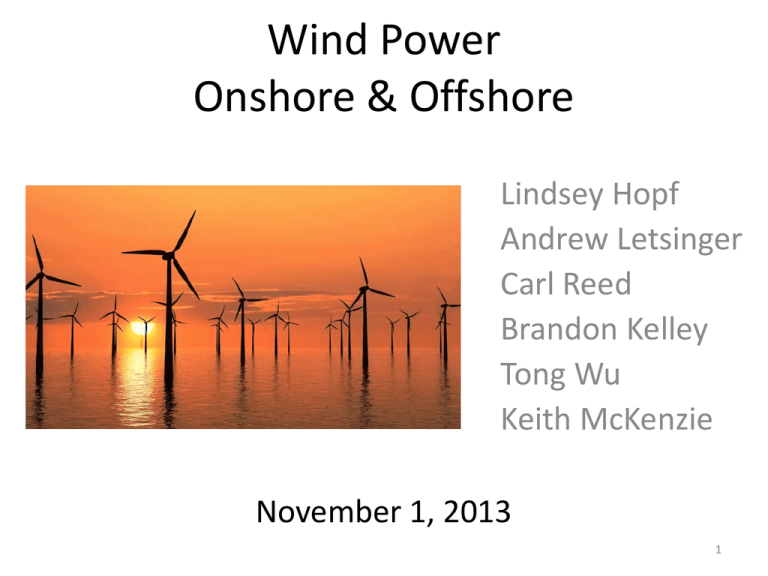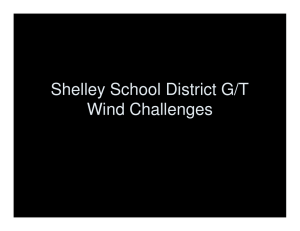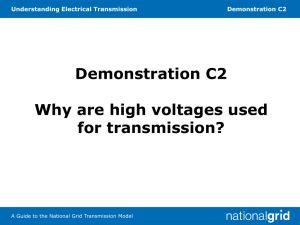Wind Power Onshore & Offshore Lindsey Hopf Andrew Letsinger
advertisement

Wind Power Onshore & Offshore Lindsey Hopf Andrew Letsinger Carl Reed Brandon Kelley Tong Wu Keith McKenzie November 1, 2013 1 Presentation Outline • History and Basic Theory • State-of-the-art Designs/Products • Impacts (Technical and Social) • Challenges or R&D Focus • True Stories of Application/Demonstration • Recent Research 2 History • Early as 5000 B.C. • 1890 – First wind turbine • 1940s – “Grandpa’s Knob” • Mid-1940s - 1970s – Decline in interest in wind turbines • 1970s – Increase in interest in wind turbine generators • Now – World’s fastest growing energy source 3 Basic Theory • Harness energy through wind’s momentum • Wind’s momentum turns blades • Blades turn the turbine • Turbine turns generator • Transformers step up voltage from generator • Power flows to a substation which connects to a transmission line 4 Animation http://www1.eere.energy.gov/wind/media/expanded_as3_single.swf 5 Presentation Outline • History and Basic Theory • State-of-the-art Designs/Products • Impacts (Technical and Social) • Challenges or R&D Focus • True Stories of Application/Demonstration • Recent Research 6 Enercon E-126 • • • • • Enercon built 7.58 MW power output Total height: 198m (650ft) Total weight: 6,000t Cost: €11,000,000 7 Turbine Details • • • • • Gearless Variable Speed Single-blade pitch adjustment Direct-drive annular motor SCADA compatible 8 Presentation Outline • History and Basic Theory • State-of-the-art Designs/Products • Impacts (Technical and Social) • Challenges or R&D Focus • True Stories of Application/Demonstration • Recent Research 9 Technical Advantage • Chart uses most conservative estimates • Others cite Wind at 0.02 pounds CO2 / kWh • Coal estimates as high as 3.6 and natural gas as high as 2 pounds CO2/ kWh 10 Technical Disadvantage Source: International Energy Agency • Distributing wind farms smooths output power • Smoother output curves, less output variability • Less variability, less cycling costs 11 Technical Impact 12 Environmental Impact 13 Social Impact 14 Impacts Overall Technical: + Renewable + No pollutants + Low operating costs + Scalable - EM Noise - Variability - Transmission Social: + Lease payments + Economic stimulus - Visual impact - Bird/bat mortality - Community conflict Presentation Outline • History and Basic Theory • State-of-the-art Designs/Products • Impacts (Technical and Social) • Challenges or R&D Focus • True Stories of Application/Demonstration • Recent Research 16 Disadvantages (Onshore) • • • • • • Reliability/Efficiency Wildlife Noise Aesthetics Geography Land Use Disadvantages (Offshore) • • • • • Price To Build Hurricane Force Winds High Risk Price For Customers ($1850/KWh) Elements R&D in Wind Power • • • • • Increasing Efficiency Reducing Cost Floating Point Structures Permit Timelines Weather Modeling Presentation Outline • History and Basic Theory • State-of-the-art Designs/Products • Impacts (Technical and Social) • Challenges or R&D Focus • True Stories of Application/Demonstration • Recent Research 20 Overall review of China's wind power industry: status quo, existing problems, and prospective for future development Background • Reduce CO2 emit/GDP – 40-50% by 2020 • Strategy • By May 2012, total capacity – 50.26 GW Two Concepts • Integrated capacity • Installed capacity • Gap – Local consumption and transmission Critical Problems • Low grid access • LVRT incapability of wind turbine • Distribution mismatch between resources and power consumption • Misalignment between wind power planning and network planning • Insufficient peak regulation capability Benefits • Promote the market of equipment and increase the utilization of wind power • Ease the contradiction between wind farms and power grid • Lay a foundation for China’s future Future Development • In the past • Switch to the large consumption places • Slow down large scale wind farm • More distributed and small-scaled installation Future Power Market • Short term, main grid will support the distributed power • Long term, owner of the distributed power can trade power with main grid • Long-distance transmission-HVDC • Connection with the HV/extra HV grid – ”Strong Smart Grid” Conclusion • At the fast-developing period • Face several problems: – Low grid access – Operation problems – Economic loss • 2 points to achieve: – Shift from concentrated construction to distributed development – Enhance the transmission capacity Presentation Outline • History and Basic Theory • State-of-the-art Designs/Products • Impacts (Technical and Social) • Challenges or R&D Focus • True Stories of Application/Demonstration • Recent Research 29 Low Voltage Ride Through (LVRT) • • Needed to avoid catastrophic cascade tripping of wind turbines. FERC Order 661A (2005). – – 3-phase fault with normal clearing (up to 9 cycles). Single line to ground fault with delayed clearing (24 cycles). 30 Magnetic Amplifier • • Magnetic amplifier is essentially a saturable reactor. Each core links with 2 windings: ac winding and control winding. – – • Sufficient dc current (ic) in control winding, core saturates (point A). Adjust ic such that core operates in linear region (point B). “Amplifier” since small change in ic causes large change in ia. 31 PMSG WT with Magnetic Amplifiers • • Magnetic amplifiers in series between PMSG and diode rectifier.. Each phase split into two windings to avoid demagnetization of magnetic amplifier during negative half cycle of supply voltage. 32 Simulation #1: No Magnetic Amplifiers DC Link Voltage IGBT Voltage • • • Voltage dips of 30%, 60%, and 90% at 0.4 s, 0.8 s, and 1.2 s. Power from wind turbine has no where to go but dc link capacitor. When voltage dips 90%, dc link voltage approaches 2 pu. 33 Sim. #2: Magnetic Amplifiers Included DC Link Voltage IGBT Voltage • • • Voltage dip of 90% at 0.5 s. Control winding PI controller senses rise in dc link voltage. Change in dc link voltage reduced dramatically. 34






